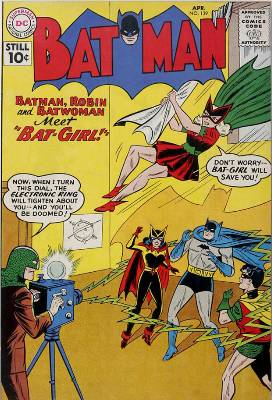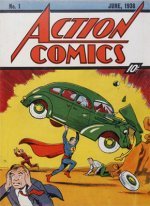Undervalued Comics: Batman 139, 1st BatGirl
Why Batman 139 is an Undervalued Comic
Every comic book collector, from novice to pro, knows the value of an issue can get a big boost when it features the debut of a new character. That’s true even when, as with Batgirl, said character was first conceived of for other media. It’s why the first appearance of a character in comic book form is often labeled a “key issue.”
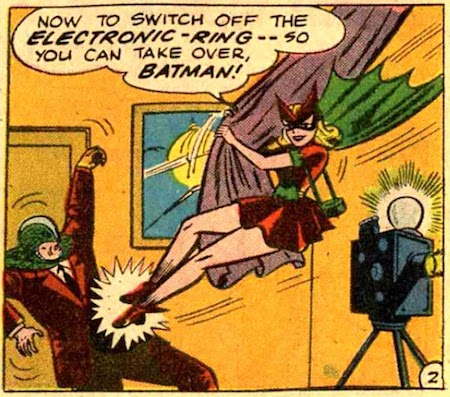 Batman #139 is an undervalued issue, featuring the first appearance of Bat-Girl, Betty Kane
Batman #139 is an undervalued issue, featuring the first appearance of Bat-Girl, Betty KaneBut Batman #139 is something special in that regard. It’s a double-key. Why? Because it’s a double-first. It’s the first appearance of the first Bat-Girl.
Did you even know there was a Bat-Girl before Batgirl? Many collectors don’t. Not even seasoned ones.
And so, you may ask, does this double-first get a corresponding double-boost in sales? Actually, Batman #139 is quite affordable. It is even, we’d argue, considerably under-valued, especially in mid-grade. Or, to put it another way, “Holy bargain-bin, Batman!"
Published Feb. 23, 1961, Batman #139 features the introduction of Betty Kane, niece and junior crime-fighting partner to super-heroine Batwoman. Both lady bats were introduced into the comics thanks to events in the real world.
You see, there was this fellow named Dr. Fredric Wertham. Freddie was a psychiatrist who got it into his head that comic books turned children into raging crime machines. This is because, after much careful study, Freddie determined that most juvenile delinquents read comic books. Therefore, ergo ipso facto, comic books caused juvenile delinquency.
Yeah, Freddie wasn’t much of a social scientist. But he was a pretty good huckster, proving amazingly adept at self-promoting his book on the topic, Seduction of the Innocent, all the way to Senate sub-committee hearings into a supposed crisis of uncontrollable kids then rampaging across the nation.
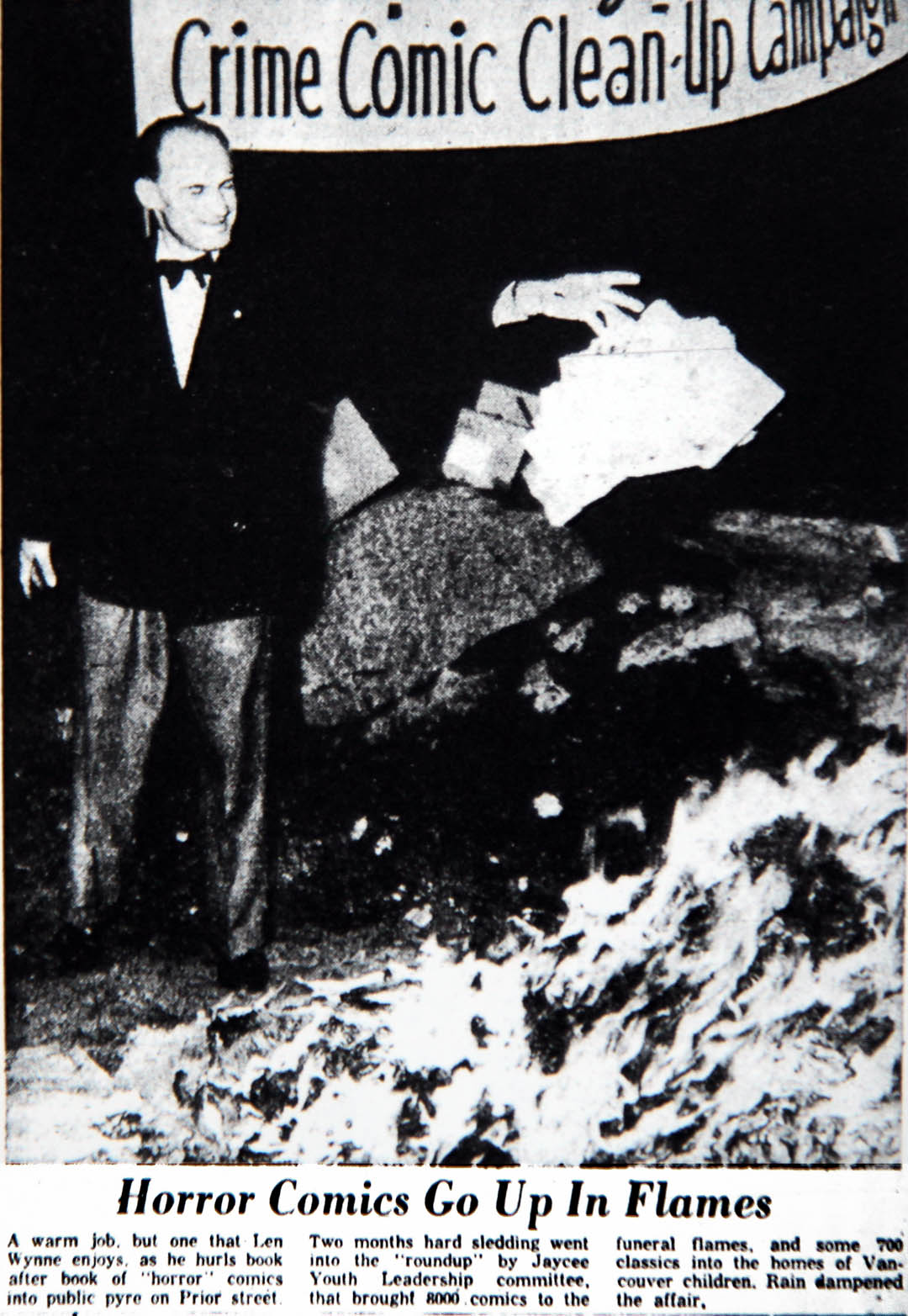 Seduction of the Innocent led to organized comic book burnings in the United States
Seduction of the Innocent led to organized comic book burnings in the United StatesAfter all, once Freddie had stirred up angry moms enough that they were conducting comic book bonfires demanding something be done, senators knew — because angry moms are voting moms — something had to be done.
And so, to head government off at the pass before it did something truly stupid, comic book publishers banded together and created the self-censoring Comics Code Authority.
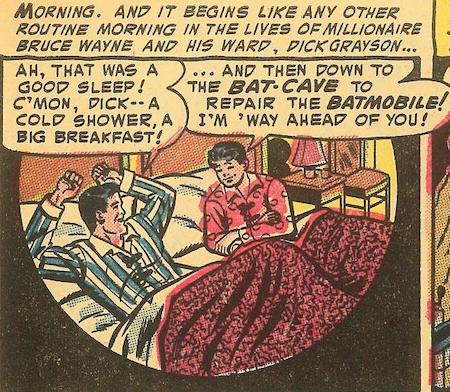 Gay subtext from Batman #84
Gay subtext from Batman #84All well and good. But that didn’t solve the problem of Batman. Batman needed special attention.
That’s because, while citing such things as panels from the comics that showed Bruce Wayne and Dick Grayson waking up together in the same room — sometimes even in the same bed — Freddie declared in his book, and in many of the magazine articles spawned by his self-aggrandizing media tour to support it, that Batman did not only encourage juvenile delinquency.
No, Batman was the basis of something far worse. He caused (gasp!) — homosexuality!
The Batman comics were, Freddie asserted, a homo-erotic fantasy of living in close confines with a young boy. And by training this boy, dressing him in a garnish, brightly-colored, bare-legged costume, and then leading him on dangerous adventures designed to create an intimate man/boy bond, Batman was what we’d call in modern parlance, a “groomer.”
Throw in Alfred the Butler, and Wayne Manor was a veritable gay sex orgy of sin and degradation.
Batman, Freddie said, had to be canceled.
But here’s the thing — DC Comics did not want to cancel Batman. Sure, the caped crusader was not then the Golden Bat-Goose he is today, but his sales weren’t nothing.
And so DC set about to put a beard on the Batman.
To start with, even as the 1954 Senate hearings were underway, they beefed up appearances by Batman’s sometime love interest, journalist Vicki Vale. But this Lois Lane clone didn’t seem to cut it.
So, for Detective Comics #233 (on-sale May 24, 1956), editor Jack Schiff tasked creative with introducing heiress Kathy Kane as the crime-busting gal-pal Batwoman, a character who would more clearly scream out to young readers — “Hey, kids! Batman likes girls!!”
Eventually, just to drive the point home, it was decided Robin needed a girlfriend as well. Thus, enter Bat-Girl.
Unfortunately, Betty’s crime-fighting career would not last long. She made a mere seven appearances before 1964, when editor Julius Schwartz was put in charge of the Batman family of titles.
Thanks in part to a new contract with Batman’s official creator Bob Kane that gave DC greater control of content, Schwartz immediately moved to modernize the books, jettisoning what he viewed as the silliness that had crept in to the Kane studio submissions under Schiff’s tenure.
Gone were Bat-Mites, But-Dogs, Bat-Aliens, and so, too, Bat-Girls.
Of course, there was still “the gay thing.”
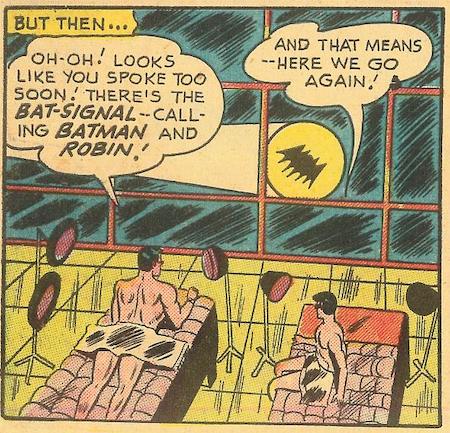 More gay subtext from World’s Finest Comics #59
More gay subtext from World’s Finest Comics #59So, in Detective Comics #328 (on-sale April 30, 1964), Scwartz killed off Alfred and replaced him with Aunt Harriet, just to lend a female influence and, one presumes, a chaperone to sleeping arrangements within stately Wayne Manor.
But then in 1966 — ZAP! POW! CRASH! — came the Batman TV show, which wanted to use both Aunt Harriet and Alfred.
That necessitated the quick revival of Alfred in the comics. But when producers later decided to sex-up the show in hopes of giving a boost to flagging ratings, they pointedly chose not to pull poodle-skirted Betty Kane out of comic book limbo. Instead, they created a new leather-clad Batgirl in the form of Commissioner Gordon’s hitherto unknown daughter, Barbara.
So, yes, while Barbara Gordon did appear in comics (starting with Detective Comics #359, on-sale Nov. 29, 1966), nearly 10 months before her debut on television screens (Sept. 14, 1967) it was at the behest of producer William Dozier, who needed the comic to sell ABC executives on a third season.
And it was Dozier, perhaps himself ignorant of the earlier Bat-Girl incarnation, who suggested the Barbara Gordon secret identity. Schawtz, hardly enamored of the earlier incarnation, did not balk.
Anyway, all that is a bit of arcane trivia about the little-known first Bat-Girl — who, by the way, has since appeared sporadically at DC, in various re-interpretations.
But here’s another thing: Comic book fans LOVE arcane trivia. They enjoy nothing more than to pull a CGC encased book off the wall, show it to a friend, and say, “Here’s something I know that you don’t know.” And if that story invoices sex, sin, and juvenile delinquency, so mach the better.
And for the investor, along with the historical provenance that lends it desirability, BATMAN #139 also has the scarcity that makes it a true collectible.
Guide to Batman 139 Comic Book Values
Rather than exponential growth, a book like Batman #139 tends to escalate in a stair-step pattern. For the next year or two, all sales in all grades should be influenced by the recent $11k pop-up.
But after that round of trading, prices will likely plateau for a bit. At least until the next surprise money spurt.
And if you are considering adding a Batman #139 to your investment portfolio, it’s not just the high grade copies that are worthy of attention. True, all grades from 3.0 to 6.5 have at least 40 certified copies, each, in circulation. However, prices on these are pretty depressed at present. Undervalued, even.
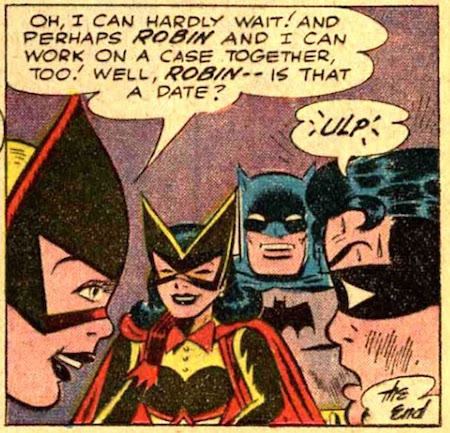 Batman #139: proof that Robin Likes Girls...
Batman #139: proof that Robin Likes Girls...Far more so than either recent high-grade sales, or the market in general, would seem to warrant.
Normally, for a key issue in certified grade, we might expect a 6.0 to fetch around 15 percent of concurrent sales in the Near Mint range, and a 2.0 to garner something like 2 to 5 percent. But the most recent 6.0 sale was a laughable $750 — less than 7 percent of the 9.4.
On the other hand, the most recent 2.0 sale ($450) was closer to the mark, at about 4 percent of the NM value. And that’s an interesting curiosity, as the same trend is indicated up and down the sales chart for the past three months on this book, where lower grades are outperforming higher ones.
Examples include a 5.0 outselling a 5.5 ($773 vs $622), a 4.0 outselling a 4.5 ($550 vs. $525), and that 2.0 outperforming even a 3.0 ($450 vs. $336). That kind of thing is generally an indication of a book getting ready to pop as it tries to hit its ceiling in the marketplace.
Our recommendation: If you have one of these mid-grade copies, you might want to hold it for just a bit longer, to await the next plateau. But if not, now may be a good time to buy and flip, as this book appears to be trying really hard to find its levels.
And there’s also the low grades to consider. For a long time, this book simply wasn’t worth certifying in anything less than 2.0. Therefore, at present, fewer than 35 CGC copies exist from 0.5 to 1.8, and none of those have sold within the past 18 months. Yet, when they did sell last, they did pretty well. A 1.5 sold in April 2021 for $375, while Dec. 2020 saw sales of a 1.8 for $225 and a 1.0 for $200.
It’s a usual pattern: Upward movement happens first at the lower grades, where most collectors can afford to enter the market, and at the high grades, where the big money plays. Those two ends then drag the middle along with them. That seems to be precisely what’s currently at play with Batman #139.
So, to review:
If you have or can get Batman #139 raw in any grade, even the lowest ones, it’s time to send it in for certification and to get it on the market as fast as you possibly can. Click here for help with consigning yours.
If you have it certified at the highest or lowest grades, it’s time to sell. Or, if you can get it at or close to current prices, best to buy and flip, because it’s starting to hit a new top end at those grades.
And, while you may want to hold on to it in middle grades for just a bit longer, waiting for that expected price spike, if you don’t have one, now seems definitely the time to buy.
But we recommend doing it fast, because when the middle meets the ends for this curious little time capsule, those new levels are likely to remain in place for a few years, at least.
Guide to Batman 139 Comic Book Values
- CGC 9.4 — $11,100
- CGC 9.2 — $4,050 (Sep. 2014)
- CGC 9.0 — $717 (May, 2010)
- CGC 8.5 — $2,880 (Jan. 2019)
- CGC 8.0 — $2,760 (Mar. 2020)
- CGC 7.5 — $3,200
- CGC 7.0 — $1,440
- CGC 6.5 — $1,026
- CGC 6.0 — $750
- CGC 5.5 — $622
- CGC 5.0 — $773
- CGC 4.5 — $525
- CGC 4.0 — $550
- CGC 3.5 — $525
- CGC 3.0 — $336
- CGC 2.5 — $375
- CGC 2.0 — $450
- CGC 1.8 — $225 (Dec. 2020)
- CGC 1.5 — $375 (Apr. 2021)
- CGC 1.0 — $200 (Dec. 2020)
- CGC 0.5 — $50 (Apr. 2020)
CGC reports just 532 Universal graded copies of Batman #139. That’s not a lot. But what’s more, just 10 of those books are graded 9.0 or better, with only 33 in the Very Fine range of 8.0 to 8.5.
High grade copies of this book don’t show up on the market all that often. An 8.5 last sold in 2019 for $2,880. More recently, in March 2020, an 8.0 went for just slightly less, $2,760.
A 9.2 has not sold since 2014, when it went for $4,050, while a 9.0 last traded in 2010, when it moved at a breathtakingly low $717. But more recently, a Near Mint 9.4 broke the psychologically-significant $10k barrier, going under the gavel for $11,100.
That sale will now undoubtedly influence the price of other high-grade copies the next time they trade. If you have one, now is a good time to sell. Click here to consign to auction!
If you don’t, but can get one at anything close to its last sale price, it’s a good time to buy and flip.
And the sooner the better. Because the original Bat-Girl is, after all, kind of a D-list character. The fun in owning a copy is in what the book represents from a real-world publishing perspective, not what it actually contains within its pages, or who worked on it.
Have this book? Click to appraise its value or Consign Yours for Auction!
INDEX OF UNDERVALUED COMIC BOOKS
Related Pages on Sell My Comic Books
Other DC Comics Characters in Batman 139

